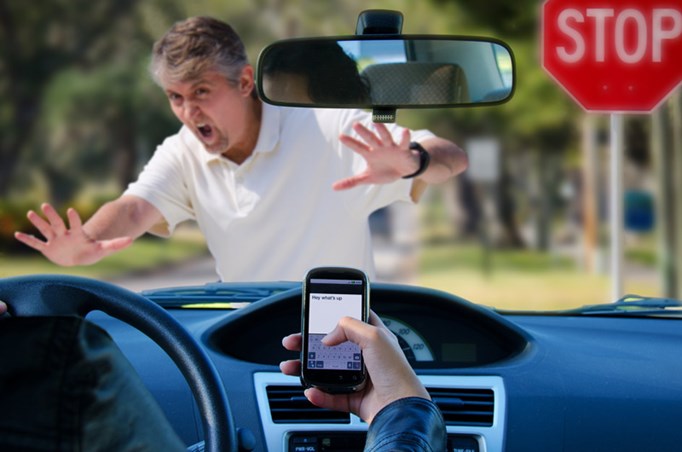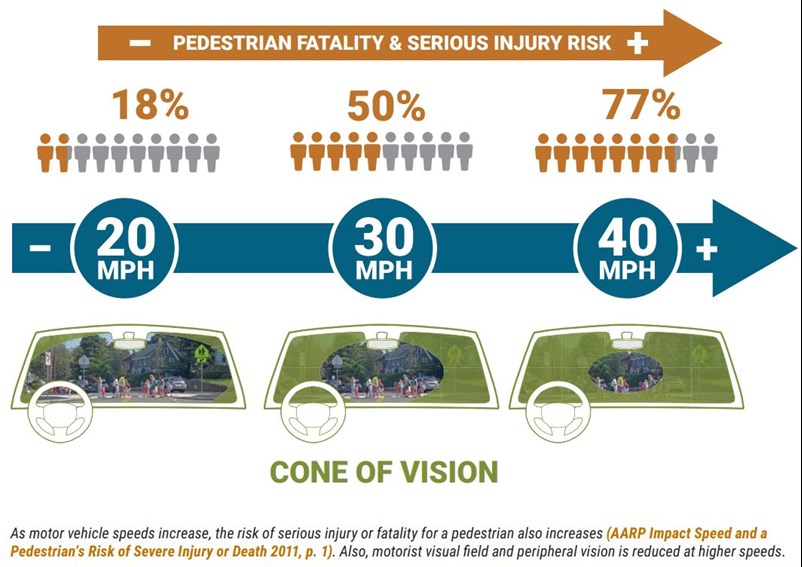Invisibility to Drivers
Drivers do not always notice people walking and biking. A common exclamation of a driver after hitting a someone walking or biking is "I didn't even see him/her!" Why is this so common and what can we do to increase the visibility and safety of Little Rock residents and visitors on bike and on foot? An obvious, but important, way to increase the visibility of someone walking or riding is for that person to wear lights and bright clothing. This page considers additional reasons for bicyclist and pedestrian invisibility and how we can address it.
Selective Attention/Inattentional Blindness
When we drive, our brains filter visual stimuli to focus our attention on things we need to notice to safely operate our car. Is the car in front of us slowing down? Is the car beside us veering into our lane? How long has the light been green? This is called selective attention (Fig. 1). The cost of selective attention is that we do not notice otherwise apparent visual stimuli. This is called inattentional blindness. Of course, seeing people on bikes and walking is important to safely operate our car, but we don't get to consciously choose on what stimuli gets our "selective attention". Our driving experience does that. This likely explains why it becomes safer to ride a bike and walk as more people in a community ride a bike and walk; these modes become more of a normal part of a city's traffic flow and they start to fall within driver's selective attentions. So, one way to increase the safety of bicyclists and pedestrians in Little Rock is get more people walking and biking.
Figure 1. Video illustrates selective attention and inattentional blindness.
Distracted Driving
While selective attention illustrates that even the most conscientious driver will not process all visual stimuli, a distracted driver voluntarily diverts his/her attention from the task of driving altogether, by texting, eating/drinking, applying make-up, etc. This dangerous activity is responsible for thousands of deaths per year and an increasing number of bicycle and pedestrian deaths. As discussed above, any collision with a vehicle extremely dangerous for someone on a bike or walking. So, another way to increase the safety of bicyclists and pedestrians is to decrease distracted driving through campaigns, enforcement, or technology. Yet another way is to better separate vehicular traffic from bicycle and pedestrian traffic with higher quality facilities such as off-street shared use paths, sidewalks, and protected bike lanes.

Figure 2. A moment's distraction while driving can be extremely dangerous.
Vehicular Speeding
Of course higher vehicular speeds can increase the likelihood and the severity of a collision, but higher vehicular speeds can also affect the visibility of bicyclists and pedestrians to drivers (Fig. 3). This is intuitive considering how selective attention works (above); the faster the brain must process visual information, the more selective it has to be about which stimuli to address. But speeding also affects where a driver's attention is focused (Fig. 3). As the driver goes faster, he/she needs to anticipate conflicts earlier. This narrows the focus and shifts it further ahead of the car. This reduces visibility of smaller objects (bicyclists and pedestrians) and objects farther from the center of the road (often bicyclists and pedestrians, who tend to operate toward or on the right side of the street). So, another way to increase bicycle and pedestrian safety is to decrease vehicular speeds and create a separate operating space for bicycles. Both of these can be achieved through a road diet, which can dramatically increase safety.

Figure 3. As driver speed increases, the driver looks through a narrower and narrower cone, which can disproportionately affect visibility of bicyclists and pedestrians, who tend to be on a street's periphery (US DOT/FHWA).
What Can We Do to Increase Visibility?
1) Wear bright clothes and lights when walking, jogging, or biking.
2) Increase the number of people biking and walking in Little Rock (inattentional blindness).
3) Do not "multitask" when driving.
4) When possible, make eye contact with a driver to verify he/she sees you. If you can't achieve eye contact, assume the driver does not see you and act appropriately.
5) Fight distracted driving with campaigns, enforcement, or technology.
6) Better separate bicycle and pedestrian traffic modes from cars by building more/better pedestrian and bicycle facilities such as sidewalks, shared use paths, and protected bike lanes.
7) Increase visibility of pedestrians and bikes in a crosswalk with more apparent striping, rapid flash beacons, and HAWK signals.
8) Drive within posted speed limits.
9) Discourage speeding by narrowing traffic lanes, e.g. through a road diet, which can dramatically improve safety.
10) Discourage speeding through more aggressive speed enforcement.




 Trash & Recycling
Trash & Recycling
 Online Payments
Online Payments
 City Documents
City Documents
 Parks
Parks
 Traffic Court
Traffic Court
 E-NEWS
E-NEWS
 EXPLORE
EXPLORE
 NEWS
NEWS
 TRANSLATE
TRANSLATE
